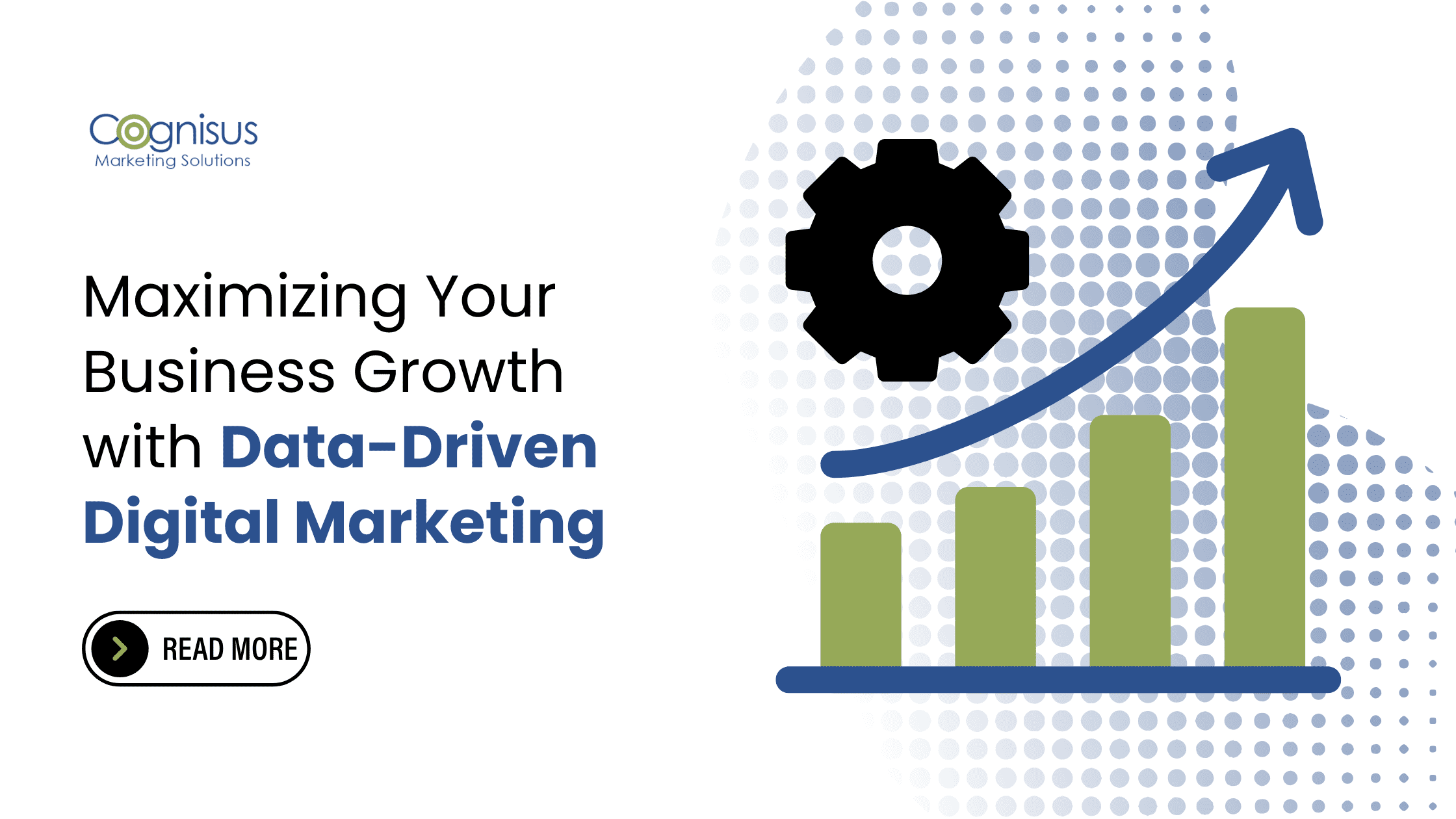Maximizing Your Business Growth with Data-Driven Digital Marketing

- Use data-driven digital marketing to improve targeting, boost conversion rates, and allocate your budget more effectively.
- Build a strategy that includes clear goals, integrated data sources, audience segmentation, and consistent performance tracking.
- Apply data insights across all channels—paid ads, content, email, SEO, and social media—to drive smarter, faster business growth.
Hello, and welcome to the Cognisus Marketing Solutions blog. This blog is all about helping business owners and marketers grow through practical, proven, and results-oriented strategies. Today, we’re diving deep into one of the most powerful concepts in modern marketing—data-driven digital marketing—and how it can significantly maximize your business growth when done right.
Let’s break down what data-driven digital marketing means, why it matters, and how you can apply it strategically to see measurable improvement in your marketing ROI.
What is Data-Driven Digital Marketing?
As the name suggests, data-driven digital marketing involves making informed decisions in your marketing strategy based on actual data. This data can come from multiple sources—customer behavior, campaign performance, demographic insights, website analytics, and more.
Instead of saying, “We think this content will work,” a data-driven approach says, “We know this content worked before with this audience—let’s build on that.”
It’s a method that replaces intuition with intelligence. And in today’s crowded online world, that makes all the difference.
Why a Data-Driven Approach is Crucial for Business Growth
Growth is the result of consistent improvements across multiple areas: targeting, messaging, conversion rates, retention, and return on investment.
Here’s why a data-first strategy is the fastest route to growth:
- Improved Targeting: Data allows you to understand who your audience really is and what they respond to. This leads to more relevant and effective campaigns.
- Higher Conversion Rates: When you tailor content, ads, and offers based on real-time data, your audience is more likely to take action.
- Better Budget Allocation: You can identify underperforming marketing channels and redirect resources to more effective strategies.
- Continuous Optimization: Data gives you feedback loops, helping you adjust strategies on the go instead of relying on quarterly reviews or “gut instinct.”
The bottom line? A data-driven digital marketing approach gives you control, and control fuels business growth.
Core Components of a Data-Driven Digital Marketing Strategy
To maximize your business growth, having access to data isn’t enough—you need a strategy to make that data actionable. Building a solid, data-driven digital marketing plan starts with putting the right foundational components in place.
These elements work together to give you clarity, direction, and continuous improvement in your marketing efforts.
Clear Objectives Aligned with KPIs
A data-driven approach is only as effective as the clarity of your goals. Before looking into analytics dashboards or campaign reporting, take the time to define what success looks like for your business. Are you aiming to increase leads? Improve customer retention? Reduce churn? Ensure that these success definitions align back to the goals, objectives, and success definitions identified in the annual strategic plan.
Each goal should map directly to specific key performance indicators (KPIs). For example:
- If your goal is to increase website visibility, track KPIs like organic traffic, bounce rate, and average session duration.
- If you’re focused on lead generation, pay attention to conversion rates, cost per lead (CPL), and form completion metrics.
- If retention is a priority, look at customer lifetime value (CLV), repeat purchase rates, and engagement over time.
Having these objectives up front ensures that your entire marketing strategy is intentional, not reactive. It also allows you to monitor progress in real time and make meaningful adjustments.
Integrated Data Sources
Your customer interacts with your business across multiple platforms—from your website to your social channels to your email campaigns. If your data lives in isolated silos, you’re only seeing fragments of the bigger picture.
Bringing all your data together creates a unified view of the customer journey. This includes integrating:
- Website analytics (e.g., Google Analytics, heatmaps)
- CRM systems that track customer interactions
- Social media engagement metrics
- Email performance reports
- Paid advertising platforms (e.g., Google Ads, Meta Ads)
When these systems are connected, you gain context. You can see how a visitor who clicked on a Facebook ad later engaged with your email newsletter and ultimately converted on your site. This integration empowers you to make smarter, more cohesive marketing decisions.
Audience Segmentation
Mass marketing doesn’t work in today’s digital environment. Consumers expect personalization, and segmentation is how you deliver it.
Using your data, you can create audience segments based on factors like:
- Demographics: Age, gender, location, and language
- Behavior: Browsing patterns, past purchases, time on site
- Engagement Level: Frequency of interaction, click-through rates
- Funnel Stage: Where someone is in their buying journey
For example, someone who’s downloaded a whitepaper but hasn’t made a purchase may need nurturing content, while a repeat customer might benefit more from upsell offers.
The goal here isn’t just to group people for the sake of it—it’s to speak to them in a way that aligns with their needs, interests, and readiness to buy. That level of relevance can significantly boost conversion rates and customer loyalty.
Performance Tracking and Reporting
Data without analysis is just noise. You need structured performance tracking to identify what’s working and what’s not.
A well-built reporting system allows you to:
- Monitor which campaigns are delivering the best return on investment (ROI)
- Identify content types that drive the most engagement
- Understand which traffic sources produce high-quality leads
- Recognize underperforming channels that may need to be reworked or paused
These insights should be reviewed consistently, not just at the end of a campaign. Real-time dashboards and weekly/monthly reporting cycles ensure that you’re agile, making informed changes instead of waiting for results to tank.
Moreover, performance tracking encourages accountability across teams. Everyone, from copywriters to media buyers, can see the direct impact of their efforts and iterate with purpose.
How to Use Data Across Different Marketing Channels
Once you adopt a data-driven approach, your entire marketing ecosystem begins to operate more efficiently. But to truly maximize your business growth, you need to understand how data functions uniquely across each channel.
Let’s walk through how to apply this mindset in the areas where it matters most.
Paid Advertising (PPC)
By analyzing performance metrics like cost-per-click (CPC), impressions, and conversion rates, you can identify which campaigns are performing well and which ones need adjusting. For instance, if your data shows that one specific ad group has a lower CPC and higher conversion rate than others, it’s a clear indicator to allocate more of your budget there.
Similarly, tracking audience behavior allows you to understand who’s engaging with your ads—age, location, device, even time of day—and tailor your targeting for better results.
Content Marketing

Content marketing thrives on relevance, and data is how you discover what’s relevant to your audience. By reviewing performance data like pageviews, time-on-page, and bounce rates, you can determine which topics and formats resonate most with your readers. Maybe you find that your how-to blogs drive significantly more traffic than thought-leadership pieces. That insight gives you a direction: create more actionable, educational content.
Likewise, if video content shows higher engagement or shares, that’s a cue to invest in that format. Data can also guide your content calendar, helping you spot seasonal trends or gaps in your existing library that need to be addressed.
Email Marketing
Email marketing is one of the most data-rich environments in your marketing toolkit—and one where small changes can drive big results. Metrics like open rates and click-through rates reveal what’s working in your subject lines and content. But to go deeper, you can segment your audience based on behaviors, interests, or past purchases, allowing you to send more personalized emails that actually get read.
For example, customers who’ve downloaded a guide might be ready for a product demo, while others who’ve only subscribed might need nurturing content. Monitoring unsubscribe rates and deliverability also helps you maintain a clean list, ensuring your campaigns are reaching the right inboxes.
SEO
Data here plays a central role in guiding your efforts. Keyword tracking helps you understand where your pages rank and what your competitors are ranking for. Organic traffic patterns reveal which topics bring in visitors and which ones bounce quickly. That tells you where to double down or revise.
Additionally, backlink profiles and domain authority trends show how your website is perceived by search engines, while content gap analysis reveals what your audience is searching for but not finding on your site. In this way, SEO becomes a strategic, insight-led process, not just a technical checklist.
Social Media
Data-driven social media is all about identifying what drives meaningful engagement and real conversions. By tracking metrics like reach, engagement rates, and click-throughs, you can evaluate which posts are prompting action and which ones are just collecting impressions. You may find that behind-the-scenes content performs better than polished graphics, or that user-generated content leads to more comments and saves.
Monitoring follower growth alongside engagement can also reveal whether you’re building an audience that truly cares about your brand or just one that scrolls past. Data even helps with logistics, like determining the best days and times to post based on when your audience is most active.
Building a Long-Term Growth Strategy with Data
To truly maximize business growth, your data-driven approach needs to be consistent, not just campaign-specific. Here’s how:
- Standardize reporting across departments and campaigns.
- Review performance monthly or biweekly, not quarterly.
- Invest in analytics training for your marketing team.
- Document insights and build a playbook of successful strategies and lessons learned.
As your campaigns evolve, your data will evolve too—so stay curious, stay nimble, and always optimize.
The Future of Marketing is Data-First
Digital marketing is becoming more competitive by the day. Businesses that thrive are those that treat data not just as a reporting tool but as the core driver of decision-making. Your audience is telling you what they want every time they interact with your content, ads, and offers. It’s up to you to listen.
With a strategic, well-executed data-driven digital marketing plan, you’re not guessing anymore. You’re growing smarter, faster, and more efficiently.
Looking to grow your business through smarter marketing? At Cognisus Marketing Solutions, we help businesses like yours unlock real results using data-backed strategies. Let’s talk about how we can build your growth engine—together. Schedule a free consultation today!
Stay tuned for our next blog, where we learn how to read between the metrics and identify real growth opportunities in your data.
